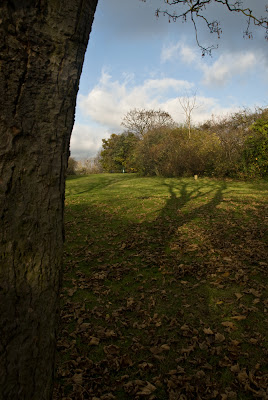Scene from Blow Up
After rewatching the film a little over a year ago, I was mesmerised by the sequences shot in the park, so decided to visit and see for myself. Although the approach to the park has been much changed since the film was shot, once inside, the row of trees marking the boundary still stands exactly as before. Just as in the film, on entering the park the noise and frenetic pace of the city are distanced. Traffic noise is still audible, but the wind in the trees, the birdsong and the distant cries of children in a school playground have the effect of cocooning you from reality, almost transporting you to a different plane. Sinclair describes a similar sensation:
“Coming into Maryon Park from Woolwich Road, as I did when I made my original investigation, is uncanny. It plays directly into the film, into the very specific sound of wind in the trees...Antonioni took a lot of trouble to identify this enclosed meadow, to see it as the essence of his film.”
The main part of the park is shaped like an amphitheatre with steep wooded sides and a rather dilapidated tennis court in the centre - the setting for the surreal mimed tennis game in the film. To the left of the court is the flight of steps leading up to the private grassy area, the scene of the lovers' tryst where the supposed murder takes place.
Scene from Blow Up
Scene from Blow Up
Antonioni's production designer, Assheton Gorton, described this location as a "theatre box", an ancient place containing powerful energies, likening its spatial design to the work of Surrealist painter de Chirico and Antonioni himself chose it because of its "charged metaphysical atmosphere" (1) This kind of mysticism can be traced back to late Victorian and Edwardian tales of the uncanny, popularised by the likes of Arthur Machen, and to the enigmatic cult of ley lines originally proposed by Alfred Watkins, where the effects of ancient events are superimposed upon the modern landscape leading to "a slipping of space and time". It is in fact a place which has connections with a much older civilisation, being the site of an ancient Roman hill fort.
I wondered whether this mysticism might just be the product of an over-active imagination, but after spending about 3 hours wandering around, I came away with the impression of a rather mournful place which did not give up its secrets easily, one where the presence of the past is almost tangible and more real than the present....
(1) Mellor, David Alan: 'Fragments of an Unknowable Whole': Michelangelo Antonioni's Incorporation of Contemporary Visualities in London, 1966












nice blog! its interesting. thank you for sharing....
ReplyDeleteLamps